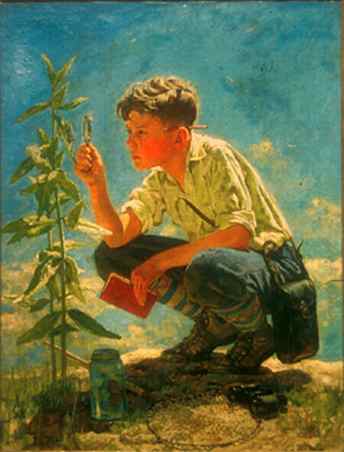|
Journal Entry - Field Notes are extremely valuable The work of art at the right is titled, Young Scientist. The subject is clearly making observations about a milkweed plant. He is holding a small, bound journal. Scientists concentrate on getting accurate data. Such evidence is obtained by observations and measurements taken in situations that range from natural settings…to completely contrived ones (such as in the laboratory). To make their observations, scientists use their own senses, instruments…that enhance those senses, and instruments that tap characteristics quite different from what humans can sense (such as magnetic fields).1
Write a title and your name at the top of the paper. pdf version What you should include in a journal: Collect and record data - Tips * Measurements - document the instruments needed to make each measurement. * Use charts or tables to organize data where appropriate. * Use your senses in making the observations. Note any patterns * You may include sketches or photos * Take an inventory of animals found - be sure to describe them using appropriate terms. How many does he see? * The classification of the plant or one animal that could be found on it. * Draw a small map of the location of the plant. * Personal observations of the environment. (Season, weather, altitude, habitat, biome) * Write a question he may wish to pursue using the scientific method. * Note what he should observe for on a subsequent visit to collect data. * Note any significant environmental issues related to what he may see. * Conclude with a statement about his or your relationship with the environment. A lesson about Science Journals Using a Dichotomous Key and a Field Guide If you are having trouble imagining what he would see, then use this real plant photo. Fields, Meadows & Fencerows EcoStudy Unit Leaf anatomy observation information off site |
George Ericson, a.k.a. Eugene Iverd (1893-1936), Young Scientist, 1932, oil on canvas, Collection: Erie Art Museum, Erie, PA. Citizen Science Projects:
Science Is a Blend of Logic and Imagination 1. American Association for the Advancement of Science. (1989). Science for all Americans: A Project 2061 report on literacy goals in science, mathematics, and technology. Washington, DC: Author. [Available online at: http://www.project2061.org/tools/sfaaol/sfaatoc.htm Aligned with the Pennsylvania State Academic Standards: Reading & Writing, Mathematics, Ecology & Environment, Geography, Science and Technology, Arts & Humanities Pennsylvania Science Anchors ISTE Standard 3 - Technology productivity tools "People can often learn about things around them by just observing those things carefully, but sometimes they can learn more by doing something to the things and noting what happens. Describing things as accurately as possible is important in science because it enables people to compare their observations with those of others. Tools such as thermometers, magnifiers, rulers, or balances often give more information about things than can be obtained by just observing things without their help." Science NetLinks Benchmark 1- Nature of science - How science works |
![]()
Internet
Hunts / Nature / Computers
/ Pennsylvania Projects / Plants
and People / Puzzles & Projects
/ Site map / Home
All trademarks, copyright and logos belong to
their respective owners.
©2003 Cynthia O'Hora All rights reserved. Updated 8/2007

